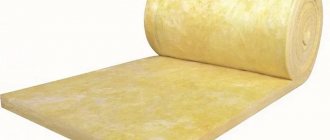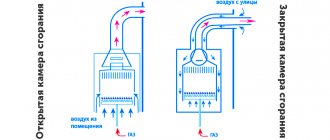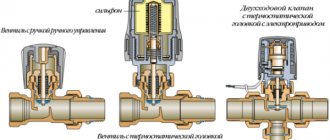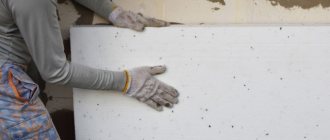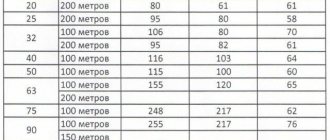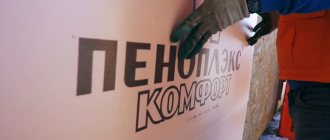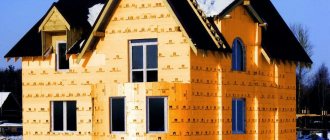The problem of choosing thermal insulation materials becomes an integral part of the work in the construction of residential buildings and industrial premises. The market offers a sufficient number of insulation materials, which differ in their composition, production technology, and recommended purpose.
Each specific type has its own advantages and disadvantages; preference should be given to the material that most accurately meets the design requirements for building insulation. Many brands under which products are manufactured duplicate the main component material and production process, but differences in the quality of the finished product are allowed.
Venerable rival
Insulation materials are essentially extruded polystyrene foam. This is a new generation of thermal insulators that can effectively retain heat. Today in the assortment of large stores you can find a number of such building materials that are used for similar purposes, but still differ in their characteristics. Let's look at and compare the most popular of them.
Penoplex competitors
Penoplex is one of the most popular foam materials , the properties of which have been improved as a result of additional processing - extrusion. Use of penoplex: attics, facades, roofs and foundations of buildings. For each of these objects there is a separate, most suitable type of slab.
Wide use of the product is possible due to a number of properties:
- Minimally absorbs water, which is important for heat insulators. A series of experiments were carried out, during which the product was left in water for several days - moisture penetrates only into the outer layers, and the internal closed cells remain dry.
- It has a low thermal conductivity coefficient (0.03 W*m*°C), and the value does not change significantly even in a humid environment. This expands the scope of application and allows the product to be used in conditions of increased dampness.
- Low vapor permeability – protects the surface well from moisture evaporation. Due to this property, a 2-centimeter layer of material can replace a layer of roofing felt.
- Long service life. During the experiments, it was established that the properties of the product do not change even after a significant change in external conditions - it was frozen and thawed, and also tested with water. The manufacturer indicated that the plates last about 50 years, but tests indicate a longer period of use.
- Compressive strength. Thanks to the production technology, the board has a homogeneous structure with evenly distributed small cells, which improves strength and resistance to mechanical stress.
- Easy installation. The material can be cut even with an ordinary knife. Self-installation is possible without the involvement of specialists.
- High level of environmental friendliness. The manufacturer used a type of freon that does not burn, is not poisonous and does not harm the environment.
- Minimal chemical activity. Does not react with most chemicals often used in construction: ketones (acetone, methyl ethyl ketone), formaldehyde, kerosene, gasoline, oil paints, etc.
- High biostability - the boards are not subject to rotting and decomposition.
It is also worth noting the following pros and cons of penoplex: materials of this type require maintaining a certain, not too high temperature. If this condition is violated, they will become deformed and may even ignite.
There are a number of foam-type slabs for insulation. They are made using similar technology, therefore they are similar in structure and properties, but, as a rule, they have different areas of application.
Foamed polystyrene - what is it?
Penoplex is produced by the company of the same name. It creates insulating material using a special technology: extruded polystyrene is foamed under high pressure. The same applies to the technology for creating Technoplex, according to open sources. It is produced by TechnoNIKOL. As for the remaining details of the process of creating Penoplex and TechnoNIKOL insulation, nothing is reported about them. True, fragmentary data leads us to the following thoughts:
- Polystyrene granules, which act as the main raw material, are mixed with the gasifier. The mixture is heated to a high temperature and pressed through small holes. In this case, polystyrene granules must be highly purified.
- As the mixture passes through the micro-hole nozzle, the flow begins to break up into microscopic threads. In this case, the polymer molecules are pulled out and form a connection with each other. And thanks to pressure, they begin to harden.
- When the polypropylene comes out of the nozzle, it begins to foam and forms a porous material with thousands of small bubbles.
Important!
In the future, we will denote Penoplex as the first, and Technoplex as the second. It turns out that based on the technology of creation, it cannot be said that Penoplex or TechnoNIKOL is better. They are almost the same, the difference lies in composition and strength. According to the TechnoNIKOL company, the composition of their products, namely Technoplex, is enriched with amphora carbon or graphite. In this case, the rolling rollers can better form the material into its final shape and thickness.
So, Penoplex is made by extrusion. And Technoplex, thanks to the inclusion of graphite nanoparticles, increases the strength of the material, and its thermal conductivity coefficient decreases even more. Both the first and second materials are environmentally safe. They are safe and non-flammable. The materials will not dissolve in water or soil.
Note! There is a big difference between well-known and cheap manufacturers.
Conventional production technology involves the use of light freons mixed with carbon dioxide as a vapor-forming gas. As for new creation methods that are much better. For their implementation, liquid and powder gas-forming agents are used.
Characteristics of the technoplex
The slabs are made using similar technology and have been produced in Russia since 2006. They do not shrink, are resistant to chemical influences, but are resistant to gasoline and solvents, and are also used inside buildings. Let's compare several parameters:
| Penoplex | Technoplex | |
| Use of buildings | roofs, facades, roads | inner part |
| Density, kg/m3 | 25-47 | 26-35 |
| Flammability group | G4 | G4 |
| Water absorption,% | 0,2-0,4 | 0.2 |
| Vapor permeability | 0,012 | 0.01 |
| Price, rub/m2 | 90-250 | 100-290 |
The main types of insulation used to reduce heat loss
To carry out thermal insulation measures of any type, the following types of insulators are used:
- extruded polystyrene foam (XPS), refers to polystyrene derivatives (represented by various manufacturing enterprises, has many brands);
- polystyrene foam, its production also involves the processing of polystyrene, but using a different technology (it has a sufficient number of manufacturers, the breakdown by brand is not clear, it is positioned as “foam plastic”).
- mineral or basalt wool is fundamentally different from polystyrene products and acts as the main competitor of foamed polystyrenes (represented on the insulating goods market by a large number of manufacturers).
The number of manufacturing companies, both domestic and foreign, is measured in dozens. When choosing products, you need to rely on the physical properties of each individual product.
Styrofoam or penoplex
A line of materials used for insulating three-layer walls, flat and pitched roofs, plinths, and underground parts of a building. Also used in the manufacture of sandwich panels, on highways and airfields.
Strength – 250-500 mPa;
Flammability group – G3 or G4;
Vapor permeability – 0.006 mg/(mh*Pa).
Installation features
The slabs can be laid on the ground under a concrete screed.
To insulate a house yourself, no special skills are required. It is enough to study the technology of work on a specific site and follow the tips and recommendations. The TechnoNIKOL Technoplex insulation is fixed with special glue and plastic dowels.
Floor insulation
Thermal insulation of floors with XPS slabs can be carried out on the ground and concrete screed. The first technology is used in rooms where the base will not experience high loads. Preparation begins with filling a layer of crushed stone. Sand is placed on top of it in a layer of up to 10 cm. Having compacted the base, sheets of expanded polystyrene are laid. Technoplex is poured with a concrete screed.
When insulating a concrete base, it is necessary to check its level. All differences are leveled with a solution. Expanded polystyrene is installed on a completely dry and clean base. In the basement, a layer of waterproofing is laid underneath it. The thickness of the sheets depends on climatic conditions, usually it is 50-80 mm. The insulation is covered with plastic film, and a damper tape is laid around the perimeter. Cement-sand mortar is poured.
If heating is provided by a water or cable electric floor heating system, heating elements and pipes are placed under the screed layer.
Thermal insulation of walls
The insulation is suitable for arranging a ventilated facade.
To fix the sheets on a vertical base, special adhesive mixtures Geresit or TechnoNIKOL are used. The insulation process begins with leveling, cleaning and priming the walls. Installation starts from the bottom. Each subsequent row is laid offset by half the length of the sheet. The adhesive composition is applied to the surface of the insulation, the plate is pressed against the wall for a few seconds. For additional fixation, 5 umbrella dowels are installed. They are placed in the corners and in the middle. The seams between the sheets are filled with polyurethane foam.
After the glue has dried, a reinforcing layer of fiberglass mesh is laid on the surface of the Technoplex. Finishing is done with plaster. After the solution has dried, the finishing coating is performed.
Foundation insulation
It is recommended to insulate the foundation from the outside. The surface is first covered with a layer of waterproofing. An adhesive mixture is applied to the expanded polystyrene boards around the perimeter and in the center. Pressing it to the foundation, hold it for 1 minute. The sheets are laid close to each other, and the subsequent rows are made with offset seams. The glue is given 2 days to dry, then the insulation is fixed with plastic dowels. The final finishing is done with plaster mortar over a reinforcing mesh.
Roof installation
Expanded polystyrene is suitable for roof insulation from the outside and from the inside.
Thermal insulation of the roof is carried out from the inside and outside. In the first case, it is possible after construction is completed. The slabs can be laid using frame and frameless technology. On a flat roof, the material is placed on a waterproofing sheet. The slabs are laid staggered, if necessary in two layers. The insulation is covered with a geotextile fabric. The finishing layer is a concrete screed or backfill with gravel.
The pitched roof is insulated along the sheathing. The bars are packed in increments of 600 mm, equal to the width of the slabs. Technoplex is laid in the sheathing, the joints are filled with polyurethane foam. The insulation layer is covered with a vapor barrier film. A counter-lattice is placed on top of the material for installation of finishing.
Technoplex insulation has all the necessary characteristics that ensure reliable and durable thermal insulation of the house.
Penoplex and expanded polystyrene: choosing the best insulation
If the insulation absorbs water, then over time its thermal insulation qualities will inevitably decrease. Extruded polystyrene foam differs from other heat-insulating materials in its minimal moisture absorption, high strength, durability and monolithic structure.
PENOPLEX is extruded polystyrene foam, the production of which is established at factories located in many cities in Russia and abroad. The most modern equipment from the world's leading manufacturers allows us to guarantee the highest quality of products under the PENOPLEX brand.
PENOPLEX insulation is chemically inert (does not emit harmful chemical compounds when used within the permissible temperature range (from -50 ° C to +75 ° C), is not subject to rotting and biodegradation. You can work with it in any weather conditions without any means protection from atmospheric precipitation.The slabs are easy to process (can be cut well using a regular knife) and are extremely simple to install.
The durability of the thermal insulation material is confirmed by NIISF protocol No. 132-1 dated October 29, 2001 (Russian Academy of Architecture and Construction Sciences) and is more than 50 years.
PENOPLEX COMFORT - specially designed for low-rise construction. The balance of technical characteristics of the universal material PENOPLEX K0MF0RT, such as: strength, zero water absorption, high thermal protection, biostability and environmental friendliness, allow it to be used effectively in all structures without overpaying for the enhanced properties of professional brands.
PENOPLEX WALL - optimal for insulating external and internal vertical enclosing structures (walls, partitions, facade systems); minimal water absorption, absolute biostability, low thermal conductivity (1.4 times more effective than mineral wool, and 1.3 times more effective than ball foam) provide reliable protection for your facade throughout its entire service life. The flammability group of PENOPLEX WALL is reduced, and the presence of special fire retardant additives makes it possible to prevent spontaneous combustion.
PENOPLEX ROOF - optimal for insulating roofs of any type; The compressive strength of this type is 25 t/m2. The flammability group of PENOPLEX ROOF is reduced, and the presence of special fire retardant additives makes it possible to prevent spontaneous combustion.
Heat conduction and moisture absorption
The thermal conductivity coefficient is one of the main parameters for insulation. The thermal conductivity parameter of the first is on average in the range from 0.028 to 0.031 W/mK, it all depends on the operating conditions. The second has an identical thermal conductivity parameter of 0.031 W/mK. It turns out that the effectiveness of materials in this area is the same.
The same applies to water absorption of materials. The first has an indicator of up to 0.2% of the volume per day, just like the second. This is truly surprising and shows that each of the materials copes well with moisture and resists it. Therefore, if anyone asks whether Penoplex or mineral wool is better, then we can confidently say that the first option. When wet, mineral wool loses its properties.
Note! The same applies to the frost resistance of the material. Its properties are not lost during frequent freezing and defrosting.
Prerequisites for the emergence of new insulating polystyrene foam materials
More recently, it was necessary to sign up in advance for the purchase of ordinary clay (red) or silicate (white) bricks, wooden logs and beams of the required section, offers for sale of which in the steppe regions of the Russian Federation were clearly not enough, to solve problems with removal and delivery by road , and sometimes by rail. The high demand for Portland cement was forced to be balanced by a sharp increase in its price, as well as the appearance on the market of a number of counterfeits (the dry material was “diluted” with furnace black or graphite, reducing its strength by 2 or more times in contrast to the declared value). Now this situation has practically improved with the advent and production of inexpensive thermal insulating technical insulation materials used in the manufacture of free-standing buildings, walls, ceilings, attics of objects under construction, allowing to reduce the volume of bricks, wooden products, and the amount of Portland cement. At the same time, along with a decrease in the overall cost of construction, it turned out to be possible to reduce its time.
